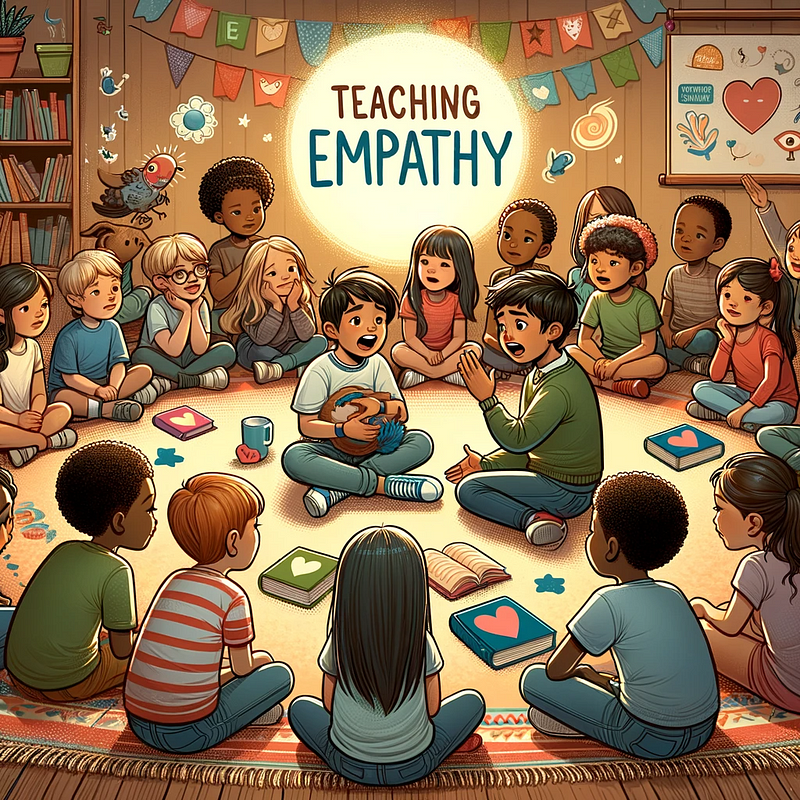Empathy: A Key to Nurturing Compassionate Children
Written on
Chapter 1: Understanding the Importance of Empathy
Empathy is a small yet powerful word with a profound influence on our lives. It serves as a vital key that opens the door to understanding and compassion, shaping our children into caring and empathetic adults. As a journalist focused on emotional intelligence, I’ve witnessed firsthand that empathy is not merely a pleasant concept; it is a skill that can be taught, learned, and beautifully expressed by children. So, parents and educators, get ready to take notes (or tap away on your tablets, because it’s the digital age), and let’s embark on this journey of fostering empathy in our future leaders, artists, scientists, and perhaps even empathetic aliens!
Before diving into practical strategies, let’s explore the reasons behind this endeavor. Empathy acts as the emotional glue that binds relationships. It transcends basic sympathy — it involves sharing feelings with others. For children, cultivating empathy is essential as it enhances emotional intelligence, assists in resolving conflicts, improves communication skills, and nurtures a sense of global citizenship. Think of it as equipping them with an emotional Swiss Army Knife — useful in nearly every life scenario.
Empathy is not an inherent trait; rather, it is a skill that must be nurtured from an early age. This is where parents and educators play a pivotal role. It begins with being a role model for empathy. Children are observant and often mimic emotions and responses. Demonstrate empathy in your actions. When you notice someone in distress, express your feelings aloud: “That person seems sad. I wonder what’s going on?” This simple act can be tremendously effective — akin to hitting the ‘copy-paste’ button in their minds for empathy.
Storytelling remains a timeless method for teaching empathy, even without the campfire ambiance. Use narratives to impart lessons on empathy. Select books featuring diverse characters and situations. After reading, facilitate discussions by asking questions like, “How do you think the rabbit felt when it lost its carrot?” This encourages children to step into the rabbit’s shoes, even if they are fictional.
A lack of emotional vocabulary can often impede empathy. Encourage children to articulate their feelings. Instead of limiting them to ‘happy’ or ‘sad,’ introduce terms like ‘frustrated,’ ‘anxious,’ and ‘elated.’ This enriches their emotional vocabulary, offering them a broader palette of feelings to express — the more colors, the better!
Role-playing isn’t just entertaining; it serves as an excellent exercise for empathy. Create scenarios where children must respond to others’ emotions. This acts as a rehearsal for real-life emotional interactions, without the anxiety of performing on stage.
Empathetic moments are scattered throughout daily life, much like hidden Easter eggs. If a sibling is feeling down, discuss ways to help them feel better. If a friend is being left out, brainstorm how to include them. These everyday instances provide opportunities for children to flex and strengthen their empathy skills.
Teaching empathy isn’t a one-time lesson; it’s an ongoing process woven into daily interactions. As parents and educators, our task is to guide, nurture, and at times, step back and observe as these young empathy saplings grow into robust, compassionate trees. Let’s commit to this beautiful journey, infusing it with humor, patience, and plenty of empathetic dialogue. And remember, in a world where you can choose to be anything, choose to be empathetic — it’s a contagious quality, in the best way possible!
As we conclude our exploration of empathy, it’s important to recognize that nurturing this quality in children is a continuous and evolving journey. Each day offers a new opportunity for them to express their understanding, kindness, and compassion. As they mature, their empathy will not only shape their lives but also impact the world around them.
If you’ve found our discussion on teaching empathy to children valuable and wish to delve deeper into emotional intelligence and its transformative potential, I invite you to subscribe to our content. By joining our community, you’ll unlock a wealth of insights, tips, and comprehensive analyses aimed at fostering a more empathetic, understanding, and emotionally intelligent society.
So, take that step, subscribe, and stay connected for more enlightening, educational, and empowering content. Together, let’s cultivate a world where empathy is not just a goal, but a lived experience. Click that subscribe button and join us on this meaningful and rewarding journey.
Section 1.1: The Role of Storytelling in Teaching Empathy
Storytelling is an invaluable tool for imparting lessons about empathy. By selecting books with diverse characters and engaging plots, we can facilitate meaningful discussions.

Section 1.2: Expanding Emotional Vocabulary
Providing children with a rich emotional vocabulary is essential for their empathy development.
Chapter 2: Practical Strategies for Fostering Empathy
This video, "Teaching Empathy to Children: Tips from MomDocs," offers practical insights on how to nurture empathy in young ones.
In this video, "How do you teach empathy? | Jonathan Juravich," discover effective methods for teaching empathy in everyday life.